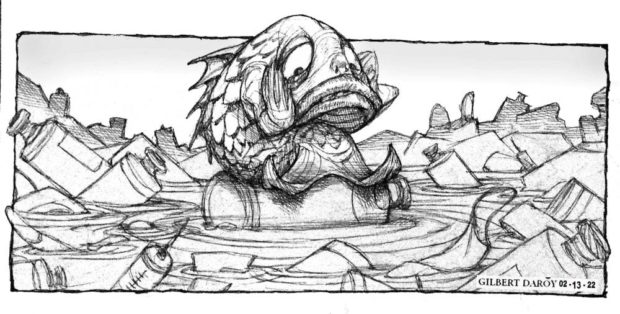Plastic pandemic

A new report commissioned by the World Wildlife Fund has grim findings: plastic, which constitutes 60 percent of marine pollution, has infiltrated even the most remote parts of the ocean; broken down into micro- and nano sizes, it has likely been ingested by almost all marine species; and may have found its way back to households through the food that people consume.
The report estimates that plastic production will double by 2040, and this in turn will quadruple the amount of plastic debris in the ocean by 2050—prompting environment advocates to make an urgent call for the world to come together and put a stop to this plastic pandemic through a global treaty.
Article continues after this advertisementThe WWF report should serve as a warning for the Philippines, a rapidly developing country surrounded by bodies of water and last year’s top contributor to the world’s plastic pollution with its 4,820 rivers. A World Bank report published in March 2021 said the country consumes a staggering 163 million pieces of sachets every day and generates 2.7 million tons of plastic waste each year—20 percent of which ends up in the ocean. The plastic pollution has threatened the livelihood of coastal communities, putting at risk fishing, shipping, and tourism industries that are directly impacted by marine debris.
The country’s waste problem has also worsened during the COVID-19 pandemic due to the increase of health care waste. The Department of Environment and Natural Resources (DENR) estimated that 1,000 metric tons of health care waste are collected daily but there have been reports indicating that waste collection and disposal remains a problem. In Lucena City, Quezon province for example, residents near the Quezon Medical Center have complained about the stench coming from a huge pile of medical waste that has been left unattended for three months. The facility arranged for the disposal of the medical waste, amounting to about 100 tons, only this month. In Catanduanes, a laboratory has been found to have dumped its medical waste, including syringes and blood sample tubes, along the shore, where seven children who played with garbage in the area later tested positive for COVID-19. Following these incidents, the Department of Health warned health facilities that they cannot operate if they do not have a proper waste management system.
The pandemic has highlighted the capacity, or lack of it, of countries like the Philippines to cope with and properly manage medical waste on top of existing solid waste management woes. Last year, the DENR practically raised the white flag when it said that the medical waste generated by COVID-19 was beyond the country’s capacity. For sure, the recent approval of home antigen test kits will further aggravate the local plastic waste problem. In addition, household waste such as food containers and packaging materials has also piled up as people turned to food delivery and online shopping due to the pandemic lockdowns. Concerned experts have pointed out that most of the packaging materials used for these services, such as bubble wrap, cannot even be reused or recycled.
Article continues after this advertisementOf significance is the House of Representatives’ approval on final reading a bill that paves the way for the eventual phase out of single-use plastic for such items like tableware, film wrap, packaging, and sachets and pouches—wastes that have been commonly found clogging the country’s coastlines and seas. But with the limited time left, it remains to be seen whether the Senate can approve a counterpart measure.
The WWF report was clear though: once plastic is distributed in the ocean, it is almost next to impossible to retrieve it, and the safety threshold for marine ecosystems has been exceeded in certain pollution hotspots like the Mediterranean, the East China and Yellow Seas, and the Arctic Sea ice. “All evidence suggests that plastic contamination of the ocean is irreversible … It steadily degrades and so the concentration of micro- and nanoplastics will continue to increase for decades,” said Heike Vesper, director of WWF Germany’s marine program. He emphasized that targeting the causes of plastic pollution, going to the root of production, is far more effective than cleaning up afterward. There is no international agreement to address this crisis, however, but WWF hopes that a global treaty setting the standards on plastics could be drawn up at the fifth session of the United Nations Environment Assembly in Nairobi from Feb. 28 to March 2.
There is no time to waste. Governments, industries, and consumers should act together now to address this crisis because contrary to that pop song, life in plastic is not fantastic.
RELATED STORY
Better plastics for healthier oceans
















